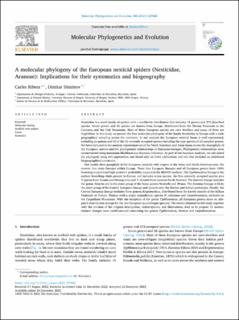| dc.contributor.author | Ribera, Carles | |
| dc.contributor.author | Dimitrov, Dimitar Stefanov | |
| dc.date.accessioned | 2023-01-25T10:37:25Z | |
| dc.date.available | 2023-01-25T10:37:25Z | |
| dc.date.created | 2023-01-10T10:41:05Z | |
| dc.date.issued | 2023 | |
| dc.identifier.issn | 1055-7903 | |
| dc.identifier.uri | https://hdl.handle.net/11250/3046198 | |
| dc.description.abstract | Nesticidae is a small family of spiders with a worldwide distribution that includes 15 genera and 272 described species. Seven genera and 56 species are known from Europe, distributed from the Iberian Peninsula to the Caucasus and the Ural Mountains. Most of these European species are cave dwellers and many of them are troglobites. In this study we present the first molecular phylogeny of the family Nesticidae in Europe with a wide geographical sampling across the continent. In our analysis the European nesticid fauna is well represented, including six genera and 40 of the 56 currently accepted species including the type species of all sampled genera. We have included in the analysis representatives of the North American and Asian fauna to test the monophyly of the European species and the phylogenetic relationships of European lineages. Phylogenetic relationships were reconstructed using maximum likelihood and Bayesian inference. As part of our Bayesian analyses, we also dated the phylogeny using two approaches, one based only on fossil calibrations and one that included an additional biogeographical constraint.
Our results show paraphyly of the European nesticids with respect to the Asian and North American taxa. We recover four main lineages within Europe. These four European lineages and all European genera have 100% bootstrap support and high posterior probability support in the BEAST2 analysis. The Typhlonesticus lineage is the earliest branching clade present in Europe and includes seven species, the five currently accepted species plus T. parvus from Bosnia and Herzegovina and T. silvestrii from western North America. The Eastern lineage includes the genus Aituaria and is the sister group of the Asian genera Nesticella and Wraios. The Domitius lineage is likely the sister group of the Central European lineage and spreads over the Iberian and Italian peninsulas. Finally, the Central European lineage includes three genera: Kryptonesticus, distributed from the karstic massifs of the Balkan Peninsula to Turkey, Nesticus with a single synanthropic species N. cellulanus and Carpathonesticus, exclusive to the Carpathian Mountains. With the exception of the genus Typhlonesticus, all European genera show an allopatric distribution (except for the two European synanthropic species). The results obtained in this study together with the revision of the original descriptions, redescriptions, and illustrations, lead us to propose 11 nomenclatural changes (new combinations) concerning the genera Typhlonesticus, Nesticus and Carpathonesticus. | en_US |
| dc.language.iso | eng | en_US |
| dc.publisher | Elsevier | en_US |
| dc.rights | Navngivelse 4.0 Internasjonal | * |
| dc.rights.uri | http://creativecommons.org/licenses/by/4.0/deed.no | * |
| dc.title | A molecular phylogeny of the European nesticid spiders (Nesticidae, Araneae): Implications for their systematics and biogeography | en_US |
| dc.type | Journal article | en_US |
| dc.type | Peer reviewed | en_US |
| dc.description.version | publishedVersion | en_US |
| dc.rights.holder | Copyright 2022 the authors | en_US |
| dc.source.articlenumber | 107685 | en_US |
| cristin.ispublished | true | |
| cristin.fulltext | original | |
| cristin.qualitycode | 2 | |
| dc.identifier.doi | 10.1016/j.ympev.2022.107685 | |
| dc.identifier.cristin | 2103842 | |
| dc.source.journal | Molecular Phylogenetics and Evolution | en_US |
| dc.relation.project | Sigma2: NN9601K | en_US |
| dc.identifier.citation | Molecular Phylogenetics and Evolution. 2023, 180, 107685. | en_US |
| dc.source.volume | 180 | en_US |

